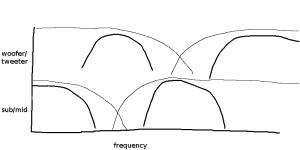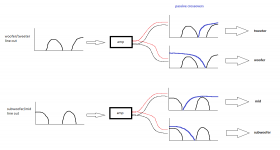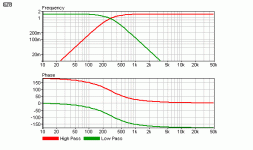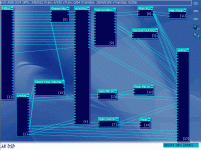3+ way speakers with only two AMPs & active line-level + passive crossover network
Hi... first post... I had an idea, wondered if it's a good idea and/or has already been done. Wanted to change the thread title to "3+ way speakers with active crossovers with only two AMPs & a line-level + passive crossover network" but too late. Respect to the technical proficiency of many on this forum — this idea's fairly simple.
I was playing around with the kx driver for Creative Audigy 2 ZS 7.1 channel sound cards and found it was easy (for a noob like me) to manipulate crossovers and band-pass filters and virtual cables to create multiple customised analogue outputs. I understand passive crossovers can cause phase distortion, so we'd rather use active line level crossovers connected to multiple amps.
If you had a 3 way speaker with frequency bands like woofer/mid/tweeter 50-200Hz/200-5000Hz/5000-20,000Hz (not sure how realistic those bands are) and programmed your sound card to output woofer + tweeter on one channel & fed it to an amp, and mid on another & fed it to a second amp, then put a cheap passive crossover system on the output from the woofer/tweeter amp with a cutoff around 2000Hz then the woofer and tweeter would get their signals cut off around 200Hz and 5000Hz by the software crossover and never experience distortion from the passive crossover cutting off inbetween them.
Or you might want a four-way speaker, which I've drawn roughly... one amp does woofer/tweeter, one does sub/mid... the thick lines indicate the line level output from the multi channel computer sound card with software crossovers, the thin lines indicate the behaviour of the passive crossovers between the amps and speaker cones (of course the source could be from any line level crossover, but it's a cost cutting plan & multichannel computer audio is cheap and a software crossovers are easy to tweak).
Hi... first post... I had an idea, wondered if it's a good idea and/or has already been done. Wanted to change the thread title to "3+ way speakers with active crossovers with only two AMPs & a line-level + passive crossover network" but too late. Respect to the technical proficiency of many on this forum — this idea's fairly simple.
I was playing around with the kx driver for Creative Audigy 2 ZS 7.1 channel sound cards and found it was easy (for a noob like me) to manipulate crossovers and band-pass filters and virtual cables to create multiple customised analogue outputs. I understand passive crossovers can cause phase distortion, so we'd rather use active line level crossovers connected to multiple amps.
If you had a 3 way speaker with frequency bands like woofer/mid/tweeter 50-200Hz/200-5000Hz/5000-20,000Hz (not sure how realistic those bands are) and programmed your sound card to output woofer + tweeter on one channel & fed it to an amp, and mid on another & fed it to a second amp, then put a cheap passive crossover system on the output from the woofer/tweeter amp with a cutoff around 2000Hz then the woofer and tweeter would get their signals cut off around 200Hz and 5000Hz by the software crossover and never experience distortion from the passive crossover cutting off inbetween them.
Or you might want a four-way speaker, which I've drawn roughly... one amp does woofer/tweeter, one does sub/mid... the thick lines indicate the line level output from the multi channel computer sound card with software crossovers, the thin lines indicate the behaviour of the passive crossovers between the amps and speaker cones (of course the source could be from any line level crossover, but it's a cost cutting plan & multichannel computer audio is cheap and a software crossovers are easy to tweak).
Attachments
Last edited:
could you explain this for me? It's a term/phrase I am not familiar with.I understand passive crossovers can cause phase distortion
Have you taken account of the combined active filter + passive filter in calculating the effects of your proposals?
I found the site that convinced me of the idea – BiAmp (Bi-Amplification - Not Quite Magic, But Close) - Part 1 – and that I should prefer active line-level crossovers & bi-amping outright.
"...with 12dB/octave filters there is a phase reversal between the low frequency and the mid+high frequency outputs"
...but also...
"Note that 24dB/octave crossovers not not suffer a phase reversal."
I attached a graph from that page, captioned "Figure 4 - Frequency And Phase Response of 12dB/Octave Crossover", it is the first google image result for "passive crossover phase".
Or this thread on this forum http://www.diyaudio.com/forums/chip-amps/59242-active-crossovers-phase-distortion.html
? Just from googling.
"...with 12dB/octave filters there is a phase reversal between the low frequency and the mid+high frequency outputs"
...but also...
"Note that 24dB/octave crossovers not not suffer a phase reversal."
I attached a graph from that page, captioned "Figure 4 - Frequency And Phase Response of 12dB/Octave Crossover", it is the first google image result for "passive crossover phase".
Or this thread on this forum http://www.diyaudio.com/forums/chip-amps/59242-active-crossovers-phase-distortion.html
? Just from googling.
............. I understand passive crossovers can cause phase distortion,................
could you explain this for me? It's a term/phrase I am not familiar with.
.................
and the first reponse was:....................
Or this thread on this forum http://www.diyaudio.com/forums/chip-amps/59242-active-crossovers-phase-distortion.html
? Just from googling.
so what are you referring to?Assuming an analog circuit, there will always be phase shift at the crossover point. I don't know that I would go so far as to call it 'distortion' though.
Last edited:
Curious why you seem to want to put woofer and tweeter on one amp and midrange on the other.
Conventional 3 way mixed active/passive crossover would have mid/tweeter crossover passive and woofer to mid active. A fewreasons -
the passive portion is usually less expensive the higher frequency you go;
tweeters and midranges tend to be more sensitive than woofers, so less passive attenuation would be needed than your proposal, most of the level matching can be done at line level;
The woofer amp is more likely to clip than the higher frequency amp. Why have the tweeter on an amp more likely to clip and hit the tweeter with hf hash? You both risk damaging your tweeter and make clipping distortion more audible by sending it to a transducer more sensitive at those frequencies.
Mixed active/passive crossovers are not novel or particularly difficult. Do you have a specific issue or question?
Conventional 3 way mixed active/passive crossover would have mid/tweeter crossover passive and woofer to mid active. A fewreasons -
the passive portion is usually less expensive the higher frequency you go;
tweeters and midranges tend to be more sensitive than woofers, so less passive attenuation would be needed than your proposal, most of the level matching can be done at line level;
The woofer amp is more likely to clip than the higher frequency amp. Why have the tweeter on an amp more likely to clip and hit the tweeter with hf hash? You both risk damaging your tweeter and make clipping distortion more audible by sending it to a transducer more sensitive at those frequencies.
Mixed active/passive crossovers are not novel or particularly difficult. Do you have a specific issue or question?
I think this could work if your goal is to reduce the amount of parts used in the passive filters. You could even use a series filter and so only need two filter parts per two drivers.
As for improving the phase shift at the crossover frequency. Do the active filters have the same phase behaviour as passive filters?
As for improving the phase shift at the crossover frequency. Do the active filters have the same phase behaviour as passive filters?
Sorry... to explain the idea behind the post — it is a cost saving idea — suppose I have two amps and four speakers – a pair of subs, woofers, mids, & tweeters (after my new pair of tweeters arrive because I fried my other ones I will have exactly that) & wish to create custom software crossovers, equalisers and volume levels for each speaker with a soundcard that can output 4 channels, but don't want to buy four amps... with this method I could do it with two channels and two amps & could still tweak the individual speakers in software (within the constraints of the passive crossovers). I spend months tweaking xo & equaliser settings, I couldn't really imagine doing it without software.
The kx driver is wonderfully intuitive & flexible, image attached (from google, not from my setup which is currently a M-Audio Delta 44, I will have to buy another second hand Creative Audigy 2 ZS or E-Mu card to finish this project if I can't find similar software that will work with a wider range of soundcards).
The kx driver is wonderfully intuitive & flexible, image attached (from google, not from my setup which is currently a M-Audio Delta 44, I will have to buy another second hand Creative Audigy 2 ZS or E-Mu card to finish this project if I can't find similar software that will work with a wider range of soundcards).
Attachments
I used kx drivers, until I upgraded my computer motherboard. But I tried to hold off on doing that for years.
I used mostly the SB0350 cards.
They all need the 4 small caps near the bottom right corner replaced. Otherwise they freeze your PC and make strange sounds. Took me years to figure this out.
Actually Audigy 2 cards even made my WiFi card disconnect and have strange issues.
BTW, I knew the onboard Realtek chipset on my mother board was going to be terrible, but it's even worse than I imagined. Makes random horrible loud static noise. Issues with every driver. Goofy noises, goofy software.
That's why I found this thread.
I'm trying to buy or somehow hookup (no PCI slots) my old Audigy 2 ZS (SB0350).
I used mostly the SB0350 cards.
They all need the 4 small caps near the bottom right corner replaced. Otherwise they freeze your PC and make strange sounds. Took me years to figure this out.
Actually Audigy 2 cards even made my WiFi card disconnect and have strange issues.
BTW, I knew the onboard Realtek chipset on my mother board was going to be terrible, but it's even worse than I imagined. Makes random horrible loud static noise. Issues with every driver. Goofy noises, goofy software.
That's why I found this thread.
I'm trying to buy or somehow hookup (no PCI slots) my old Audigy 2 ZS (SB0350).
- Home
- Source & Line
- Analog Line Level
- Running 3+ way speaker setup with only two AMPs & a multi-channel computer sound card



